City of London: Difference between revisions
m clean up, typos fixed: viscious → vicious, However → However, , Lloyds of London → Lloyd's of London, Peasant's Revolt → Peasants' Revolt, self governing → self-governing, has has → has |
No edit summary |
||
| Line 8: | Line 8: | ||
|longitude=-0.091302 | |longitude=-0.091302 | ||
|population=11,000 | |population=11,000 | ||
|post town=London | |||
|postcode=EC, WC, E1 | |postcode=EC, WC, E1 | ||
|LG district=City of London | |LG district=City of London | ||
| Line 13: | Line 14: | ||
|website=[http://www.cityoflondon.gov.uk The Corporation of London] | |website=[http://www.cityoflondon.gov.uk The Corporation of London] | ||
}} | }} | ||
The '''City of London''' is a city of [[Middlesex]], lying at the heart of the vast conurbation which has borrowed its name, for it is the City of London itself, the square mile, is the true owner of the name of [[London]]. The confusion between the two usages is such that the City of London is now known popularly as just '''The City''' or '''The Square Mile'''; terms applied as much to the financial services whose home is London as to the place. | The '''City of London''' is a city of [[Middlesex]], lying at the heart of the vast conurbation which has borrowed its name, for it is the City of London itself, the square mile, that is the true owner of the name of [[London]]. The confusion between the two usages is such that the City of London is now known popularly as just '''The City''' or '''The Square Mile'''; terms applied as much to the financial services whose home is London as to the place. | ||
The City is the historic core of London around which the modern conurbation grew. It has held city status since time immemorial.<ref name="beckett">{{cite book | title=City status in the British Isles, 1830–2002 | series=Historical urban studies | author=Beckett, J V | year=2005 | publisher=Ashgate | location=Aldershot | isbn=0-7546-5067-7 |page=12}}</ref> The City’s boundaries have remained barely unchanged since the Middle Ages, apart from the absorption of the former City Liberties, now with an area of just over one square mile | The City is the historic core of London around which the modern conurbation grew. It has held city status since time immemorial.<ref name="beckett">{{cite book | title=City status in the British Isles, 1830–2002 | series=Historical urban studies | author=Beckett, J V | year=2005 | publisher=Ashgate | location=Aldershot | isbn=0-7546-5067-7 |page=12}}</ref> The City’s boundaries have remained barely unchanged since the Middle Ages, apart from the absorption of the former City Liberties, now with an area of just over one square mile | ||
| Line 234: | Line 235: | ||
==References== | ==References== | ||
{{Reflist|30em}} | {{Reflist|30em}} | ||
{{Cities in the United Kingdom}} | |||
Latest revision as of 12:49, 30 March 2016
| City of London | |
| Middlesex | |
|---|---|
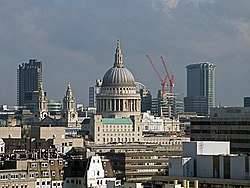 St Paul's and the City of London | |
| Location | |
| Grid reference: | TQ325814 |
| Location: | 51°30’58"N, 0°5’29"W |
| Data | |
| Population: | 11,000 |
| Post town: | London |
| Postcode: | EC, WC, E1 |
| Local Government | |
| Council: | City of London |
| Parliamentary constituency: |
Cities of London and Westminster |
| Website: | The Corporation of London |
The City of London is a city of Middlesex, lying at the heart of the vast conurbation which has borrowed its name, for it is the City of London itself, the square mile, that is the true owner of the name of London. The confusion between the two usages is such that the City of London is now known popularly as just The City or The Square Mile; terms applied as much to the financial services whose home is London as to the place.
The City is the historic core of London around which the modern conurbation grew. It has held city status since time immemorial.[1] The City’s boundaries have remained barely unchanged since the Middle Ages, apart from the absorption of the former City Liberties, now with an area of just over one square mile
The City is today a major business centre: the greatest financial centre in the world, closely pursued by New York City. Another major financial district is Canary Wharf, 2½ miles to the east, outside the City but intimately connected with it and essentially a colony founded by its businesses.
People and business
The City has a resident population of a little over 11,000, but around 316,700 people work there, mainly in the financial services sector.
The legal profession forms a major component of the western side of the City, especially in the two liberties, the Inner Temple and Middle Temple, and in the Chancery Lane areas, in and around the Inns of Court.
Many national and international banks have their headquarters in the City; the most prestigious place of business for them. The Bank of England is here. The London Stock Exchange is here too, Lloyd's of London and many other top financial institutions, and others in related businesses drawn by the great institutions and the prestige of the city. The City of London is thus the heart of the banking and financial services, for which reason "The City" and "The Square Mile" are terms used to refer to high finance and top-end financial services. The City is the greatest centre of high finance in the world.
Name of the City
The name of London is ancient. The Romans named their city Londinium (and later Augusta, though the latter did not stick.) Londinium is however from an original in the old British language, which is lost. The Welsh name for London is Llundain, which may hint at the form of the original. Many have suggested possible origins; from "Ship Hill" in reference to the twin hills of the city, Ludgate Hill and Cornhill,rising like prows of a ship, to the fanciful legends of King Lud.
In Old English the city became known as Lunden, and hence today the name is pronounced in the Old English style but spelled as if in Latin.
History
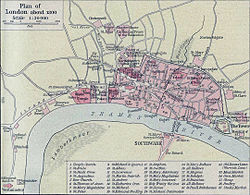
Roman origins
Of London before the Romans nothing is known for sure, though the name appears to be Old British.
It is believed that Roman London was established as a trading port by merchants on the tidal Thames around 47 AD. The new settlement and port were centred where the shallow valley of the Walbrook meets the Thames. However, in AD 60 or 61, little more than ten years after Londinium was founded, it was sacked by the Iceni, led by their queen Boudica. Londinium was rebuilt as a planned settlement (a civitas) soon after and the new town was prosperous and grew to become the largest settlement in Roman Britain by the end of the 1st century. By the beginning of the 2nd century, Londinium had replaced Camulodunum as the capital of Roman Britain.
At its height, the Roman city had a population of approximately 45,000–60,000 inhabitants. The Romans built the London Wall some time between 190 and 225. The boundaries of the Roman city were similar to those of the City of London today, though Londinium did not extend further west than Ludgate/the River Fleet and the Thames was considerably wider than it is today, thus the shoreline of the city was north of its present position. The Romans built a bridge across the river, as early as 50 AD, near to where London Bridge stands.
A number of Roman sites and artefacts can be seen in the City of London today, including sections of the London Wall (at the Barbican and near the Tower of London), the London Stone, the Temple of Mithras and remains of the amphitheatre beneath the Guildhall. The Museum of London, in the City, holds many of the Roman finds and has permanent Roman exhibitions, as well as being a source of information on Roman London generally.
Decline of Londinium
By the time of the construction of the London Wall, the city's fortunes were in decline, with problems of plague and fire. The Roman Empire entered a long period of instability and decline, including the Carausian Revolt in Britain. In the 3rd and 4th centuries, the city was under attack from Picts, Scots and Saxon raiders. The decline continued, both for Londinium and the Empire, and in 410 AD the Romans withdrew entirely from Britain. Many of the Roman public buildings in Londinium by this time had fallen into decay and disuse, and gradually after the formal withdrawal the city became almost (if not, at times, entirely) uninhabited. The centre of trade and population moved away from the walled Londinium to Lundenwic, a new town to the west, possibly in the modern day Aldwych/Covent Garden area.
Anglo-Saxon restoration
During the days of the kingdoms of the English, London first came under the kingdom of Essex, then from the seventh century it was held by the Kingdom of the Mercians and then later Wessex, though was frequently under the control or threat of the Vikings and Danes.
Alfred the Great, King of Wessex occupied and began the resettlement of the old Roman walled area, in 886, and he appointed his son-in-law Earl Æthelred of Mercia over it as part of their reconquest of the Viking occupied parts of England. The refortified Anglo-Saxon settlement was known as Lundenburh ("London Fort", a borough). The historian Asser stated that "Alfred, king of the Anglo-Saxons, restored the city of London splendidly ... and made it habitable once more."[2] Alfred's "restoration" entailed reoccupying and refurbishing the nearly deserted Roman walled city, building quays along the Thames, and laying a new city street plan.[3]
Alfred's taking of London and the rebuilding of the old Roman city was a marking point in history, not only as the permanent establishment of the City of London, but also as part of a unifying moment in early English history, with Wessex becoming the dominant English kingdom and the repealing (to some degree) of the Viking occupation and raids. Whilst London, and indeed England, afterwards would continue to come under further periods of Viking and Dane raids and occupation, the establishment of the City of London and the Kingdom of England prevailed.[4]
In the 10th century, Athelstan permitted eight mints to be established in London, compared with six in his capital, Winchester, indicating the wealth of the city. London Bridge, which had fallen into ruin following the Roman evacuation and abandonment of Londinium, was rebuilt by the kings, but was periodically destroyed by Viking raids and storms.
As the focus of trade and population was moved back to within the old Roman walls, the older Saxon settlement of Lundenwic was largely abandoned and gained the name of Ealdwic (the "old settlement"). The name survives today as Aldwych (the "old market-place"), now a name given to a street and an area which lies between Westminster and the City of London.
Mediæval and early modern periods
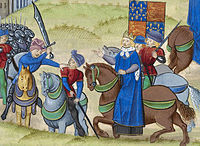
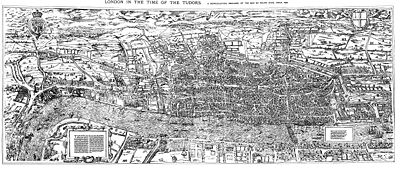
Following the Battle of Hastings, William the Conqueror marched on London, to Southwark and failed to get across London Bridge or to defeat the Londoners. He eventually crossed the River Thames at Wallingford, pillaging the land as he went. Rather than continuing the war, Edgar Ætheling (Edgar II), Edwin of Mercia and Morcar of Northumbria surrendered at Berkhamsted. William rewarded London in granting the citizens a charter in 1075; the City of London was one of the few institutions where the English retained some authority. The City was not covered by the Domesday Book.
William ensured against attack by building three castles nearby, to keep the Londoners subdued:
- Tower of London
- Baynard's Castle
- Montfichet's Castle
In 1132, Henry I gave the city full internal control of its government, and by 1141 the whole body of the citizenry was considered to constitute a single community. This 'commune' was the origin of the City of London Corporation and the citizens gained the right to appoint, with the king's consent, a Mayor in 1189 and to directly elect the Mayor from 1215.
The City continues to be composed of 25 ancient wards, each headed by an Alderman, who chair the Wardmotes. There was a Folkmoot for the whole of the city held at the outdoor cross of St Paul's Cathedral. Many of the mediæval positions and traditions continue to the present day, demonstrating the unique institution which the City, with its Corporation, is.
The Plague and the Great Fire of London
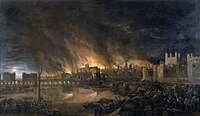
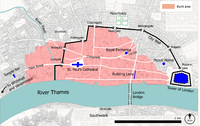
The City was burned severely on a number of occasions, the worst being in 1123 and then again (and more famously) in the Great Fire of London in 1666. Both of these fires were referred to as the Great Fire.
Before the fire of 1666, the city was visited by an older curse; in 1664-1666, the Great Plague of London raged; a vicious outbreak of bubonic plague though the last. The plague had been a recurring threat to London's crowded, filthy streets for centuries and several outbreaks had struck the city even in that century. That of 1664 was described memorably in the next century in Daniel Defoes A Journal of the Plague Year. Resolute action prevented the speread of the plague across the nation as had happened before, though it did escape sufficiently to devastate several villages, but London suffered grievously.
The next year, in 1666, fire broke out in a shop in Pudding Lane. It swiftly caught hold and though the spread was said to be slow, it was relentless; the Great Fire of London destroyed some 80% of the city.
Rebirth from the flames
After the fire, a number of plans were drawn up to remodel the City and its street pattern into a renaissance-style city with planned urban blocks, squares and boulevards. These plans were almost entirely not taken up, and the mediæval street pattern re-emerged almost intact.
By the late 16th century, London increasingly became a major centre for banking and international trade and commerce. The Royal Exchange was founded in 1565 by Sir Thomas Gresham to act as a centre of commerce for London's merchants and gained Royal patronage in 1571. Although no longer used for its original purpose, its location at the corner of Cornhill and Threadneedle Street continues to be the geographical centre for the City's core of banking and financial services, with the Bank of England moving to its present site in 1734, opposite the Royal Exchange on Threadneedle Street.
Growth of London
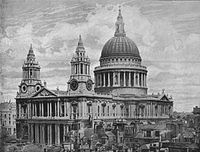
The 18th century was a period of rapid growth for London, reflecting an increasing national population, the early stirrings of the Industrial Revolution, and London's role at the centre of the evolving British Empire. The urban area expanded beyond the borders of the City of London, most notably during this period towards the West End and Westminster.
In 1708 Christopher Wren's masterpiece, St. Paul's Cathedral, was completed on his birthday. However, the first service had been held on 2 December 1697; more than 10 years earlier. This Cathedral replaced the original St. Paul's which had been completely destroyed in the Great Fire of London and is considered to be one of the finest in Britain and a fine example of Baroque architecture.
Expansion continued and became more rapid by the beginning of the 19th century, with London growing in all directions. To the East the Port of London grew rapidly during the century, with the construction of many docks, needed as the Thames at the City could not cope with the volume of trade. The arrival of the railways and the Tube meant that London could expand over a much greater area. By the mid-19th century, with London still rapidly expanding in population and area, the City had already become only a small part of the wider metropolis.
19th & 20th centuries
In 1894 a proposal was pushed forward to amalgamate the City and the surrounding Administrative County of London, but it did not succeed. The City of London therefore survived, and does so to this day, despite its situation within the far wider metropolitan conurbation and numerous local government changes. Regarding representation to Parliament, the City elected four members to the unreformed House of Commons, which it retained after the Reform Act 1832 and into the 20th century. Today it is included wholly in the Cities of London and Westminster constituency, and statute requires that it may not be divided between two neighbouring areas.
The City's population fell rapidly in the 19th century and through most of the 20th century as people moved outwards to London's vast suburbs and many houses were demolished to make way for modern office blocks. The largest residential section of the City today is the Barbican Estate, constructed between 1965 and 1976. Here a major proportion of the City's population now live. The Museum of London is located here, as are a number of other services provided by the Corporation.
The City, like many areas of London and other British cities, fell victim to large scale and highly destructive aerial bombing during Second World War, in what is known as The Blitz. Whilst St Paul's Cathedral survived the onslaught, large swathes of the City did not and the particularly heavy raids of late December 1940 led to a firestorm called the Second Great Fire of London.
A major rebuilding programme therefore occurred in the decades following the war, in some parts (such as at the Barbican) dramatically altering the City's urban landscape. The destruction of the City's older historic fabric however allowed, and continues to allow, the construction of modern and larger-scale developments in parts of the City, whereas in those parts not so badly affected by bomb damage, the City retains its older character of smaller buildings. The street pattern, which is still largely mediæval, was altered slightly in certain places, although there is a more recent trend of reversing some of the post-war modernist changes made, such as at Paternoster Square.
The 1970s saw the construction of tall office buildings including the 600-foot, 47-storey Natwest Tower, which became the first skyscraper in the UK. Office space development has intensified especially in the central, northern and eastern parts of the City, with further skyscrapers being built including 30 St Mary Axe, Broadgate Tower and the Heron Tower, the tallest in the City. A fifth, the Bishopsgate Tower is set to begin rising in late 2010, and will overtake the Heron Tower to become the tallest building in the City of London, and the second tallest in Britain after the under-construction Shard of Glass at London Bridge Station.
Arms of the City
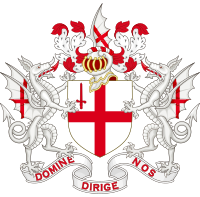
The Corporation of the City of London has a full achievement of armorial bearings (shield, crest, helm and supporters). The blazon of the arms is as follows:
Arms: Argent a cross gules, in the first quarter a sword in pale point upwards of the last.
Crest: On a wreath argent and gules a dragon's sinister wing argent charged on the underside with a cross throughout gules.
Supporters: On either side a dragon argent charged on the undersides of the wings with a cross throughout gules.
The coat of arms of the City is "anciently recorded" at the College of Arms. They were in use in 1381, as they formed part of the design of a new mayoralty seal taken into use on the 17 April of that year. These arms consist of a white shield bearing a red cross with a red upright sword in the first quarter. The design combines the emblems of the patron saints of England and London: the Cross of St George with the symbol of the martyrdom of Saint Paul. The 1381 arms replaced an earlier shield, found on a charter of 1319, that depicted St Paul holding a sword.[5]
The sword is often erroneously supposed to commemorate the killing of Peasants' Revolt leader Wat Tyler by the Lord Mayor of London William Walworth. However the arms were in use some months before Tyler's death, and the tradition that Walworth's dagger is depicted may date from the late 17th century.[6][7][8]
The crest and supporters came into use in the 17th century but were used without authority until 30 April 1957 when they were confirmed and granted by letters patent from the College of Arms.[5]
The crest is a dragon's wing bearing the cross of St George, borne upon a peer's helm. A primitive form of the crest first appeared in 1539 on the reverse of a new common seal. This showed a fan-like object bearing a cross. Over time this evolved into a dragon's wing, and was shown as such in 1633 when it appeared above the city's coat of arms in the frontispiece to the fourth edition of John Stow's Survey of London. It has been speculated that the use of a peer's helmet (rather than that of a gentleman, used in other civic arms) relates to the use of the honorific prefix "The Right Honourable" by the Lord Mayor.[7] The helm was confirmed in 1957.
On the seal of 1381 two lions were shown supporting the arms. However, by 1609 the present supporters, two white dragons bearing red crosses upon their wings, had been adopted.[5][7] The dragons were probably suggested by the legend of St George and the Dragon.[6]
The Latin motto of the City of London is "Domine dirige nos", which translates as "Lord, direct (guide) us". It appears to have been adopted in the 17th century, as the earliest record of it is was first recorded in 1633.[5][7]
The Corporation
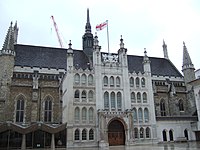
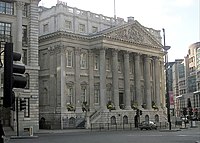
The Mayor and Commonalty and Citizens of the City of London, to give it its full title; the Corporation of London governs the City. The Corporation is an ancient institution, pre-dating the Norman Conquest and it has a unique political status, a legacy of its uninterrupted integrity as a corporate city since the Anglo-Saxon period and its singular relationship with the Crown. Historically its system of government was not unusual, but it was not reformed by the Municipal Reform Act 1835 and little changed by later reforms.
The Corporation has changed somewhat since Moule's description of it as "of enormous wealth; whose practical inefficiency, and steadfast resistence of all reformation or change, are matters of painful notoriety". Wealth it retains, but the Corporation may be the most effective and efficient local authority today.
The Corporation is responsible for local government functions and owns and manages also an estate of properties within and beyond the City's boundaries.
- The Lord Mayor of London is the head of the Corporation. The office is an ancient one (and unrelated to the more recently created position of "Mayor of London"). The Lord Mayor has precedence amongst all the mayors of Britain, and uniquely among them is entitled to be addressed as "The Right Honourable". The Lord Mayor is elected by the Livery Companies.
- The Court of Aldermen is now largely ceremonial. The Court of Aldermen represents the wards, and each ward (irrespective of their size) returning one Alderman.
- The Court of Common Council ("the Mayor, Aldermen, and Commons of the City of London in Common Council assembled") is the effective governing body.
- The Court of Husting is the most ancient body, effectively a borough court, though no longer having judicial authority and thus no more than ceremonial.
- Sheriffs: The City appoints two Sheriffs, who are quasi-judicial offices and who are appointed by the Livery Companies. Each Sheriff serves for one year. The Lord Mayor must have served a year as a sheriff.
- The Town Clerk of London is the Chief Executive of the administrative side of the Corporation's work.
Livery Companies
The Livery companies of London represent an ancient political system, based on the representation and protection of trades. Senior members of the Livery Companies are known as Liverymen and form a special electorate called the Common Hall — this body chooses the Lord Mayor of the City, the Sheriffs and certain other officers.
Livery companies
There are over one hundred livery companies in London. The companies were originally guilds or trade associations. The senior members of the livery companies, known as liverymen, form a special electorate known as Common Hall. Common Hall is the body that chooses the Lord Mayor, the sheriffs and certain other officers.
Wards
The City is made up of 25 wards, which had their boundaries changed in 2003, though the number of wards and their names did not change. They are survivors of the mediæval governmental system that allowed a very local area to exist as a self-governing enclave within the wider city.[9] They can be described as being both electoral/political divisions and permanent ceremonial, geographic and administrative entities within/sub-divisions of the City. Each ward has an Alderman, who traditionally held office for life but in the modern era put themselves up for re-election at least every 6 years. Wards continue to have Beadles, ancient functionary offices that are largely ceremonial in the modern era, the main remaining function being the running of the Wardmote, an annual meeting in each ward of electors, representatives and officials.[10] At the Wardmote the ward's Alderman appoints at least one Deputy for the year ahead. Each ward also has a Ward Club, which is similar to a residents' association found elsewhere in the country.[11]
The wards are ancient and their number has only changed three times since time immemorial: in 1394 Farringdon was divided into Farringdon Within and Farringdon Without; in 1550 the creation of Bridge Without, south of the river, with the ward of Bridge becoming Bridge Within;[12] and the merger of Bridge wards Within and Without, in 1978, into the present-day Bridge Ward.[13]
Following changes to the City of London's boundary in 1994 and later reform of the business vote in the City, a major boundary and electoral representation revision took place to the wards in 2003. The ward boundaries and electoral representation were reviewed again in 2010 for change in 2013, though not to such a dramatic extent. The review was conducted by senior officers of the Corporation and senior judges of the Old Bailey;[14] the wards are not reviewed by the Electoral Commission under the Parliamentary Constituencies Act 1986 and (unlike with other local government electoral reviews in the country) the number and the names of the wards do not change. Particular churches, livery company halls and other historic buildings and structures are associated with specific wards, such as St Paul's Cathedral with Castle Baynard, or London Bridge with Bridge. Boundary changes in 2003 did remove some of these connected places from their wards, but that boundary review and the current review do take into account of these historic/traditional connections.
Elections
The City has a unique electoral system. Most of its voters are representatives of businesses and other bodies that occupy premises in the City. Its ancient wards have very unequal numbers of voters. In elections, both the businesses based in the City and the residents of the City vote.
The business franchise remains nowhere else in Britain, though in the City it allows a proper reflection of the city: 330,000 non-residents constitute the city's day-time population and use most of its services, far outnumbering the City's residents, who number around 11,000. Until a private Act of Parliament which the Corporation obtained in 2002, only partnerships might provide a voter, not corporations which form by far the greatest set of businesses in the city. Under the new system, the number of non-resident voters has doubled from 16,000 to 32,000.
Bodies employing fewer than ten people may appoint one voter; those employing ten to 50 people may appoint one voter for every five employees; those employing more than 50 people may appoint ten voters and one additional voter for each 50 employees beyond the first 50.
The Temples
Inner Temple and Middle Temple (which adjoin each other) are two of the few remaining liberties: independent extra-parochial areas, historically exempt from the rule of the City of London Corporation and are today regarded as local authorities for most purposes.[15] Geographically they fall within the boundaries and liberties of the City, but can be thought of as independent enclaves. They are both part of the Farringdon Without ward of the City.
Other functions
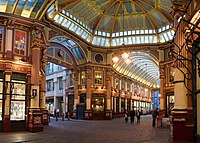
Within the City, the Corporation owns and runs both the Smithfield Market and Leadenhall Market. The Corporation owns and is responsible for a number of locations beyond the boundaries of the City. These include various open spaces (parks, forests and commons) in and around greater London, including most of Epping Forest, Hampstead Heath and many public spaces in Northern Ireland through The Honourable The Irish Society. It also owns Old Spitalfields Market and Billingsgate Fish Market, both of which are within the neighbouring London Borough of Tower Hamlets. The Corporation also owns and helps fund the Old Bailey, the Central Criminal Court for England and Wales, as a gift to the nation, it having begun as the City and Middlesex Sessions.
The City has its own independent police force, the City of London Police - the Common Council (the main body of the Corporation) is the police authority.[16] The rest of Greater London is policed by the Metropolitan Police Service, based at New Scotland Yard.
The City of London has one hospital, St Bartholomew's Hospital. Founded in 1123 and commonly known as 'Barts', the hospital is at Smithfield, and is undergoing a long-awaited regeneration after many doubts as to it continuing in use during the 1990s.
The City is the third-largest funding-patron of the arts in the United Kingdom. It oversees the Barbican Centre and subsidises several important performing arts companies.
The Corporation oversees the running of the Bridge House Trust, which maintains five key bridges in central London, London Bridge, Blackfriars Bridge, Southwark Bridge, Tower Bridge and the Millennium Bridge. The City's flag flies over Tower Bridge, although neither footing is in the City.[17]
Gardens and public art
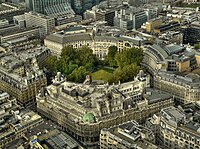
The City has no sizeable parks within its boundary, but does have a network of a large number of gardens and small open spaces, many of which are maintained by the Corporation. These range from formal gardens such as the one in Finsbury Circus, containing a bowling green and bandstand, to churchyards such as one belonging to the church of St Olave Hart Street, to water features and artwork found in some of the courtyards and pedestrianised lanes.[18]
Gardens include:
- Barber-Surgeon's Hall Garden, London Wall
- Cleary Garden, Queen Victoria Street
- Finsbury Circus, Blomfield Street/London Wall/Moorgate
- Jubilee Garden, Houndsditch
- Portsoken Street Garden, Portsoken Street/Goodman's Yard
- Postman's Park, Little Britain/Aldersgate
- Seething Lane Garden, Seething Lane
- St Dunstan-in-the-East, St. Dunstan's Hill/Idol Lane
- St Mary Aldermanbury, Aldermanbury
- St Olave Hart Street churchyard, Seething Lane
- St Paul's churchyard, St Paul's Cathedral
- West Smithfield Garden, West Smithfield
- Whittington Gardens, College Street/Upper Thames Street
Additionally there are a number of private gardens and open spaces, found often within courtyards of the larger commercial developments. Two of the largest private gardens are those of the Inner Temple and Middle Temple Inns of Court, in the far southwest of the City.
The Thames and its riverside walks are increasingly being valued as open space for the City and in recent years efforts have been made to increase the ability for pedestrians to access and walk along the river.
Economy
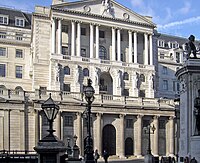
The City vies with New York City as the financial capital of the world and many banking and insurance institutions have their headquarters there. The London Stock Exchange (shares and bonds), Lloyd's of London (insurance) and the Bank of England are all based in the City. Over 500 banks have offices in the City, and the City is an established leader in trading in Eurobonds, foreign exchange, energy futures and global insurance. The Alternative Investment Market, a market for trades in equities of smaller firms, is a recent development. In 2009, the City of London accounted for 2.4% of UK GDP.
London is the world's greatest foreign exchange market, with much of the trade conducted in the City of London. Of the $3.98 trillion daily global turnover, as measured in 2009, trading in London accounted for around $1.85 trillion, or 36.7% of the total. The Pound Sterling, the currency of the United Kingdom, is globally the fourth most traded currency and the third most held reserve currency.
Since 1991 Canary Wharf, a few miles east of the City, has become a second centre for London's financial services industry and houses many banks and other institutions formerly located in the Square Mile. Although growth has continued in both locations, the Corporation has come to realise that obstructive planning policies were causing financial firms to increasingly choose Canary Wharf as a location.
Landmarks
Historic buildings
Fire, bombing and post-War redevelopment has meant that the City, despite its history, has relatively few intact notable historic structures remaining. Those that are present today include the Monument to the Great Fire of London ("the Monument"), St Paul's Cathedral, the Guildhall, the Royal Exchange, Dr Johnson's House, Mansion House and a great many churches, many designed by Sir Christopher Wren, who also designed St Paul's. 2 King's Bench Walk and Prince Henry's Room are notable historic survivors of heavy bombing of the Temple area, which has largely been rebuilt to its historic form. Another example of a bomb-damaged place having been restored is Staple Inn on Holborn.
A few small sections of the Roman London Wall exist, for example near the Tower of London and also in the Barbican area. Among the twentieth century listed buildings are Bracken House, the first post WWII buildings in the country to be given statutory protection, and the whole of the Barbican and Golden Lane Estate.
The Tower of London is not within the City, but is a notable visitor attraction which brings tourists to the southeast of the City. Other landmark buildings include a number of the modern high-rise buildings (see section below) as well as the Bank of England, the Old Bailey, Smithfield Market and the Lloyd's building.
Tall buildings

Once is was said that the soft clay of the city would not support such buildings as tower over New York, and H G Wells in The Shape of Things to Come alludes to a catastrophic collapse of the ground caused by the tall buildings of his day, which force the River Thames out of its course.
Since the 1980s this conventional wisdom has been turned on its head and many towers have been raised and others are under construction.
Outside links
- Official websites
- City of London Corporation - the City's local government website
- Visit the City - the City's visitor website
- Museum of London
- Geographical information
- City of London Corporation: Ward boundary maps
- City of London Police: Alternative ward map
- MAPCO : Map And Plan Collection Online - High resolution historic maps of London c. 1560-1925
- Local information
References
- ↑ Beckett, J V (2005). City status in the British Isles, 1830–2002. Historical urban studies. Aldershot: Ashgate. p. 12. ISBN 0-7546-5067-7.
- ↑ Asser's Life of King Alfred, ch. 83, trans. Simon Keynes and Michael Lapidge, Alfred the Great: Asser's Life of King Alfred & Other Contemporary Sources (Penguin Classics) (1984), pp. 97-8.
- ↑ Vince, Alan, Saxon London: An Archaeological Investigation, The Archaeology of London series (1990).
- ↑ London: The Biography, 2000, Peter Ackroyd, p. 33-35
- ↑ 5.0 5.1 5.2 5.3 "The City Arms". Corporation of London Records Office. http://www.cityoflondon.gov.uk/NR/rdonlyres/65DC8039-12C4-4AC4-8DAD-16F1608E99B7/0/cityarms.PDF. Retrieved 17 April 2011.
- ↑ 6.0 6.1 Scott-Giles, C Wilfrid (1953). Civic Heraldry of England and Wales, 2nd edition. London: J M Dent & Sons. pp. 245–246.
- ↑ 7.0 7.1 7.2 7.3 Fox-Davies, A C (1915). The Book of Public Arms, (2 ed.). London: T C & E C Jack. pp. 456–458.
- ↑ Crosley, Richard (1928). London's Coats Of Arms And The Stories They Tell. London: Robert Scott. pp. 14–21.
- ↑ The City of London - a history Borer, M.I.C. : New York,D.McKay Co, 1978 ISBN 0094618801 p112
- ↑ City of London Corporation Ward Motes
- ↑ City of London Corporation Ward Boundaries, Beadles and Clubs
- ↑ Guildhall Library Manuscripts Section City of London wards
- ↑ Bridge Ward Club History of the Bridge wards
- ↑ Corporation of London Ward Boundary Review (2010)
- ↑ Middle Temple as a local authority
- ↑ "Police Reform and Social Responsibility Act 2011". Legislation.gov.uk. 2011-10-26. http://www.legislation.gov.uk/ukpga/2011/13/contents/enacted/data.htm. Retrieved 2011-10-30.
- ↑ "City of London". britishflags.net. http://www.britishflags.net/cityoflondon.html. Retrieved 2011-10-30.
- ↑ "Gardens of the City of London". Gardens of the City of London. http://www.gardensofthecityoflondon.co.uk. Retrieved 2011-10-30.
| Cities in the United Kingdom |
|---|
|
Aberdeen • Armagh • Bangor (Caernarfonshire) • Bangor (County Down) • Bath • Belfast • Birmingham • Bradford • Brighton and Hove • Bristol • Cambridge • Canterbury • Cardiff • Carlisle • Chelmsford • Chester • Chichester • Colchester • Coventry • Derby • Doncaster • Dundee • Dunfermline • Durham • Ely • Edinburgh • Exeter • Glasgow • Gloucester • Hereford • Inverness • Kingston upon Hull • Lancaster • Leeds • Leicester • Lichfield • Lincoln • Lisburn • Liverpool • City of London • Londonderry • Manchester • Milton Keynes • Newcastle upon Tyne • Newport • Newry • Norwich • Nottingham • Oxford • Perth • Peterborough • Plymouth • Portsmouth • Preston • Ripon • Rochester • Salford • Salisbury • Sheffield • Southampton • St Albans • St Asaph • St David's • Southend-on-Sea • Stirling • Stoke-on-Trent • Sunderland • Swansea • Truro • Wakefield • Wells • Westminster • Winchester • Wolverhampton • Worcester • Wrexham • York |